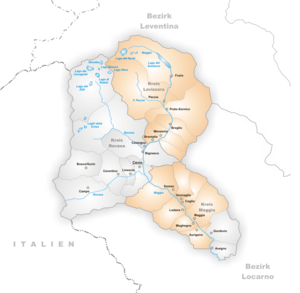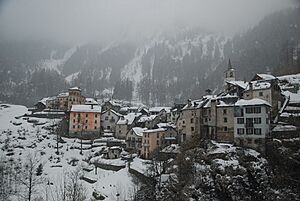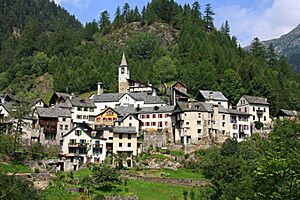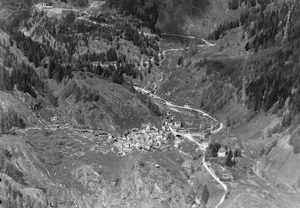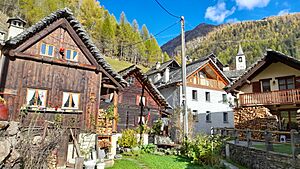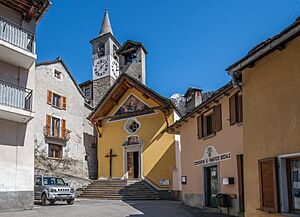Fusio facts for kids
Fusio is a small village located in the Vallemaggia district of Ticino, a canton in Switzerland. It used to be its own town (called a municipality), but in 2004, it joined with several nearby towns. These towns included Broglio, Brontallo, Menzonio, Peccia, and Prato-Sornico. Together, they formed a new, larger municipality called Lavizzara.
Contents
A Look Back: Fusio's History
Fusio was first mentioned in old records way back in 1258. Its name then was Fuxio.
The village grew a lot between the 1500s and 1600s. At that time, about 400 to 500 people lived there. But by the late 1700s, the number of people slowly started to drop. After 1950, this decline became much faster. Many people moved away to bigger cities for work and other opportunities. Today, most of the people still living in Fusio are older.
The main church in Fusio is dedicated to the Beata Vergine Assunta. It was first made a church in 1455. For a while, it was a smaller church connected to Sornico. But in the 16th century, it became more independent. It was rebuilt several times, especially in the 1600s.
How People Lived and Worked
For a long time, the people of Fusio made their living from animals, especially by using pastures for grazing. They also relied on forests for wood. The village had huge areas for grazing animals. This might be why not many people from Fusio moved overseas, unlike in some other places.
Until the late 1800s, there were two mines in Fusio. These mines produced a soft stone called steatite, also known as soapstone.
In the 1950s, a large dam was built in the Sambuco valley nearby. This project reduced the amount of land available for farming. However, starting in the 1980s, new houses and an inn were built in Fusio. This helped bring some new life and visitors to the village.
The Hamlet of Mogno
A small settlement called Mogno was also part of Fusio. In the 1600s, about 50 families lived there. By 1801, only 40 people remained. Today, Mogno is not lived in all year round. It mainly serves as a holiday village for people visiting the area. Before 1936, Mogno was part of Peccia. The land around it was shared by Fusio, Peccia, and Prato-Sornico.
Mogno has its own church, San Giovanni Battista Decollato. It was built in 1626. It started as a small chapel connected to Peccia's main church. By the late 1600s, it became its own independent church. In 1940, it joined the Fusio church area. Sadly, an avalanche destroyed this church in 1986. A new church was built in 1997. It was designed by a famous architect named Mario Botta. This new building has a very unique look. It has become a popular spot to visit and has sparked a lot of discussion.
Where is Fusio? Geography and Landscape
Fusio covers an area of about 60.78 square kilometers (about 23.47 square miles). This was measured in 1997.
Let's break down how the land is used:
- Only about 1% of the land is used for farming.
- Nearly 20% is covered by forests.
- Less than 1% has buildings or roads.
- About 4% of the area is rivers or lakes.
- More than half (about 56%) is unproductive land, meaning it's too rocky or has too little vegetation to be used for farming or building.
The village is located in the Vallemaggia district. It is the highest village in the Val Lavizzara valley. Fusio sits at an elevation of about 1,289 meters (4,229 feet) above sea level. It is about 46 kilometers (29 miles) away from Locarno, a larger town. A beautiful lake called Lago di Mognola is located above the village.
Fusio's Coat of Arms
A coat of arms is like a special symbol or emblem for a town or family. Fusio's coat of arms has three parts. It shows a black pot, two golden nails crossed, and a green tobacco plant.
- The pot represents the Lavizzara valley, where Fusio is located.
- The nails and the tobacco plant are special symbols for two families from the village. The "Chiodi" family's name means "nail" (chiodo in Italian). The "Tabacchi" family's name means "tobacco" (tabacco in Italian). So, these symbols are a fun way to represent those families!
Who Lives in Fusio? Demographics
As of December 2000, Fusio had a population of 45 people. Over the ten years before that (from 1997 to 2007), the population didn't change much.
Most people in Fusio speak Italian. In 2000, 40 people (about 89%) spoke Italian. Four people (about 9%) spoke German, and one person (about 2%) spoke Portuguese.
In 2000, about two-thirds of the people (30 out of 45) were born in Fusio and still lived there. A few others were born in the same canton (Ticino) or elsewhere in Switzerland. Five people (about 11%) were born outside of Switzerland.
Most of the buildings in Fusio are single-family homes. In 2000, there were 112 inhabited buildings, and 103 of them were single-family homes. Many of these homes (60) were built between 1919 and 1945.
There were 113 apartments in the village in 2000. Most of them (93 apartments, or 82%) were used only during certain seasons, like for holidays. Only 20 apartments (about 18%) were lived in all year round.
The chart below shows how Fusio's population has changed over time:

Economy: How People Earn a Living
In 2000, 16 people in Fusio had jobs. About 37.5% of these workers were women. Only 4 workers had to travel outside the village for their jobs.
Religion in Fusio
According to the 2000 census, most people in Fusio were Roman Catholic. About 91% (41 people) belonged to the Roman Catholic Church. There was also one person who belonged to another Christian church. Three people (about 6.7%) did not belong to any church.
Education in Fusio
In Fusio, about 26.7% of the population (12 people) had finished high school. A smaller number, 3 people (about 6.7%), had gone on to higher education, like a university or a specialized college. All three of these people were Swiss men. In 2000, only one student from Fusio attended school outside the village.


